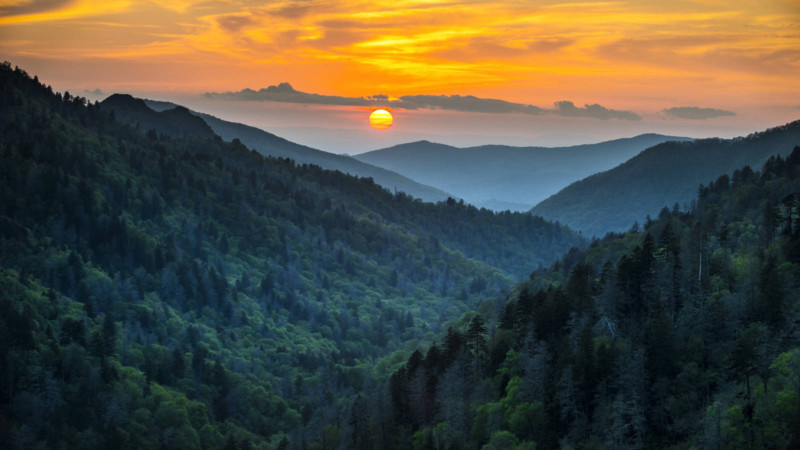Spring marks the beginning of outdoor activities for many. The South has a lot of great State and National parks to visit and camp at. These are our 20 we feel you should have on your bucket list.
- Great Smoky Mountains National Park – Spread over the North Carolina-Tennessee border, the Great Smoky Mountains National Park is over 500,000 acres of Southern Appalachian natural beauty, wildlife and culture. It is the USA’s most visited national park. Cade’s Cove is the most popular place to visit. The first Europeans settled in the cove sometime between 1818 and 1821. By 1830 the population of the area had already swelled to 271. Cades Cove offers the widest variety of historic buildings of any area in the national park. Scattered along the loop road are three churches, a working grist mill, barns, log houses, and many other faithfully restored eighteenth and nineteenth century structures.
- Hot Springs National Park – Nestled around the spa town of Hot Springs, Arkansas, Hot Springs National Park is home to 5,550 acres of hilly forest, scenic hiking trails and of course the thermal hot springs from which the park gets its name, whose healing powers have been used for over 100 years. Babe Ruth used to hold Spring practice here, and Oaklawn Park is considered one of the nation’s premiere horse tracks.
- Mammoth Cave National Park – Located in the hilly terrain of south central Kentucky, Mammoth Cave National Park was designated in 1941 with the mission of protecting the labyrinthine cave system, which, with more than 400 miles of explored passages mapped, is the longest known cave system in the world. Perfect for summer trips.
- Everglades National Park – The USA’s biggest subtropical wilderness, the Everglades National Park was established in 1947 with the mission of protecting the unique and diverse ecosystem of the wetlands and encompasses the southern part of the Everglades region. Spanning 1.5 million acres it’s home to a diverse wildlife and botanical spectrum.
- Congaree National Park – Congaree National Park was designated in 2003 as a means of protecting the South Carolina area’s beautiful floodplain forest and the unique ecosystem it plays host to. Spread across over 25,000 acres, Congaree National Park’s floodplain is fed by the nutrient-rich waters of the Congaree and Wateree rivers and is home to the largest tract of bottomland hardwood forest still standing in the southeastern region.
- Shenandoah National Park – Rugged mountains, serene hollows and beautiful waterfalls can be found in Virginia’s Shenandoah National Park. It’s hard to believe that Washington D.C. is less than 100 miles away. While the park is easily explored via car on Skyline Drive, a gorgeous stretch of road that runs the entire length of the park and part of the Blue Ridge Parkway , there are plenty of places to get out and explore.
- Big Bend National Park – There is a place in Far West Texas where night skies are dark as coal and rivers carve temple-like canyons in ancient limestone. Here, at the end of the road, hundreds of bird species take refuge in a solitary mountain range surrounded by weather-beaten desert. Tenacious cactus bloom in sublime southwestern sun, and diversity of species is the best in the country. Over 200 miles of hiking trails highlight this park that is bigger than Rhode Island.
- Tallulah Gorge State Park – One of the most spectacular canyons in the eastern U.S.is in Georgia. Tallulah Gorge is two miles long and nearly 1,000 feet deep. Visitors can hike rim trails to several overlooks, or they can obtain a permit to hike to the gorge floor (100 per day, not available during water releases). A suspension bridge sways 80 feet above the rocky bottom, providing spectacular views of the river and waterfalls. Tightrope walkers have twice crossed the gorge, and visitors can still see towers used by Karl Wallenda. A paved path follows an on old railroad bed, perfect for strollers and bicycles, while mountain bikers can test their skills on a challenging 10 mile trail.
- Foss State Park – An earthen dam was constructed to create Foss Lake in Oklahoma. When finished in 1961, the dam was 142 feet high and more than 3 miles long. It remains one of the largest earthen dams in the nation. Can’t wait for Christmas? Neither can the folks at the park. Foss State Park celebrates the holiday very early with its Christmas in July event celebrating military history by honoring veterans. It takes place the weekend following July 4, and highlights include live music, fireworks, a motorcycle parade and a 5K and color run across the dam.
- Roaring River State Park – Roaring River State Park is a public recreation area covering of 4,294 acres eight miles south of Cassville in Barry County, Missouri. The state park offers trout fishing on the Roaring River, hiking on seven different trails, and the seasonally open Ozark Chinquapin Nature Center.
- Fall Creek Falls State Park – Tennessee’s biggest and best-loved state park, Fall Creek Falls State Park is made up of 26,000 acres resting atop the rugged terrain of the Cumberland Plateau.
- Padre Island National Sea Shore – One of the best stretches in Texas is Padre Island national seashore, which protects the longest undeveloped stretch of barrier island in the world: a narrow, 70-mile long spit of dunes and tidal flats teeming with sea life. Female turtles journey from all over the Atlantic Ocean to lay their eggs here.
- Douthat State Park – Douthat State Park is a state park located in the Allegheny Mountains in Virginia. It is in Bath County and Alleghany County. The park is 4,545 acres total with a 50-acre lake.
- Gorges State Park – This relatively new 7,500 acre North Carolina State Park is set in the midst of plunging waterfalls, rugged river gorges, sheer rock walls and a high concentration of rare species.
- Gulf State Park – Miles of white sand beaches, 6500 acres of park land, and the Gulf’s longest pier.
- Tishimingo State Park – Located in the foothills of the Appalachian Mountains in Mississsippi, Tishomingo State Park is steeped in history and scenic beauty. Archaeological excavations confirm the presence of Paleo Indians in the area now encompassed by the park as early as 7000 B.C.! The park takes its name from the leader of the Chickasaw nation, Chief Tishomingo. The famous Natchez Trace Parkway, the premier highway of the early 1800s and a modern scenic parkway, runs directly through the park.
- Canaveral National Seashore – Located in Florida, since ancient times, this barrier island has provided sanctuary to both people and wildlife. Many threatened and endangered species find refuge here, including sea turtles who nest on its shores. Like first natives and early settlers, you too can find tranquility. Stroll down a wooded trail. Reflect on a pristine undeveloped shoreline
- Blackwater Falls State Park – Located in the Allegheny Mountains of Tucker County, Blackwater Falls State Park is named for the amber waters of Blackwater Falls, a 57-foot cascade tinted by the tannic acid of fallen hemlock and red spruce needles. The falls, the main attraction of Blackwater Falls State Park, are accessible from steps and several viewing platforms that allow visitors to enjoy scenic views year-round. Blackwater Falls, and nearby Elakala Falls, Lindy Point and Pendleton Point Overlook, are some of the most photographed sites in West Virginia. The park offers lodging and many outdoor recreational opportunities.
- Huntington Beach State Park – Huntington Beach State Park is on the coast of South Carolina. Its Atlantic beach and wetlands are inhabited by sea turtles, alligators and rich birdlife. The Sandpiper Pond Nature Trail has a viewing deck on a pond that attracts egrets and herons. The Kerrigan Nature Trail includes a boardwalk over a lagoon. Atalaya, a vast 1930s Moorish-style castle, was the home of the Huntingtons, who once owned the land.
- Daniel Boone National Forest – The Daniel Boone National Forest is a national forest in Kentucky. Established in 1937, it includes 708,000 acres of federally owned land within a 2,100,000 acres proclamation bounty. The name of the forest was changed in 1966 in honor of the explorer Daniel Boone





